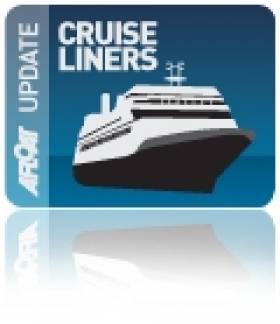Displaying items by tag: MV Albatross
Port of Cork Welcomes MV Albatros, Final Cruise Call of 2013
#portofcork – The Port of Cork welcomed MV Albatros, the final cruise liner of the 2013 season to Cobh today following what the Port of Cork confirmed as the 'busiest cruise season on record for Cork'.
In total, 62 cruise liners called to the Port of Cork, home to Ireland's only dedicated cruise berth, carrying a record 123,000 passengers and crew. These guaranteed visitors are a welcome treat for Cork, bringing a much needed boost to the local economy for eight months of the year. In 2013 eight liners made their maiden calls to the Port of Cork, highlighting the continuing growth of this business and the commitment from cruise companies to introduce new ships to the region.
While some of these cruise calls stay overnight, many stay for a full day allowing their passengers ample time to enjoy the many exciting shore excursions on offer or simply time to experience Cork City and region independently. According to Irish Rail, statistics for the cruise season showed up to 28% of cruise passengers took the train from Cobh to Cork City. For all of the larger liners, Irish Rail offers extra trains to ensure passengers can get to Cork City without delay. This works well for passengers, with many deciding to take the train from Cobh to Cork in the morning and spend the afternoon in Cobh or take one of the ship's shore excursions in the afternoon.
It is imperative that passengers are offered a choice of shore excursions, both full and half day, so they tailor what is offered to suit them. The more choice there is for passengers the better, as this works in favour particularly for repeat passengers. It is well noted within the cruise industry that it is incumbent on all ports, destinations and shore tour operators to reinvent themselves occasionally, to attract both new and repeat passengers. The same must be done for Cork and the Port of Cork continues to work with City and County Councils, Irish Rail, Tour Operators and attractions to ensure Cork continues to meet the demand of cruise lines and their passengers.
Speaking about the busiest cruise season on record for Cork, Mr John Mullins Chairman of the Port of Cork said: "This has been an excellent year for Cork and we have seen a huge jump in passenger numbers this year. This increase is down to the dedicated cruise berth and the number of calls of large cruise ships. For example Princess Cruise's ship, MV Caribbean Princess called seven times this year, each time bringing over 4,000 passengers and crew to Cork. The fact that people can just walk on and off the ship to go shopping or touring increases the economic impact to the region. The passengers are offered the option of taking a tour and then come back on the ship to change before going out again on their own to do some shopping, eating or drinking and avoiding the repeated hassle of tendering or shuttle buses."
With these ambitious plans however, the Port of Cork cannot achieve them alone.
Mr Mullins continued: "There are also a great amount of activities and attractions on offer in Cork and the region for cruise passengers, and we remain fully committed to increasing our calls from 62 this year to 80 in the next five years. To do this, we need the continued support of Irish Rail to offer more trains with added incentives, the tour operators need to design and offer new shore excursions at competitive prices and we need the continued support from both City and County councils to encourage the promotion of the region, so that everything Cork has to offer is utilised to its full potential."
Over the years, the Port of Cork has invested in the cruise business and this is something the Port is committed to continuing. As cruise ships get larger, cruise companies are searching the globe for suitable ports capable of handling such vessels. Cork has a huge advantage over other Irish ports in that it is a naturally deep-water port with no restrictions; however, Cork needs to enhance the facilities in Cobh to be able to handle even larger liners and to have the option of accommodating two liners at one time.
Following this excellent cruise season, the Port of Cork would like to express their thanks to all their Cork Cruise members, Irish Rail, TEAM, tour operators, bus companies, travel agents and the many different attractions around the region for their continued support and cooperation with the cruise business. The Chairman thanked the board of directors at the port, management team and staff for realising the potential of this business for both the Port and the local economy, and their commitment to provide future infrastructure to support the business.





























































